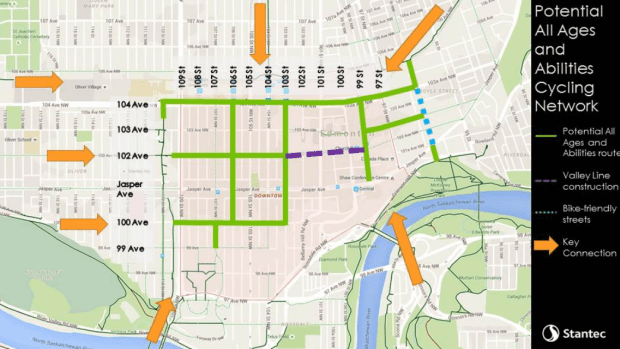Grid of segregated bike lanes coming to Edmonton in 2017
The city's mayor hopes to see the newly approved bike infrastructure extended to the University of Alberta in 2018


A grid of segregated bike lanes is coming to Edmonton. The infrastructure, CBC reports, will have a far-reaching impact in terms of accessibility in the city.
According to Edmonton cyclists, the grid is also long-overdue.
Recently, Edmonton’s city council unanimously voted to create a network of segregated downtown bike lanes—some 7.1-km worth in all, at a cost of $7.5 million—that will follow a similar design esthetic already seen in other Canadian cities. The segregated routes will be divided from downtown traffic by planters in some places or concrete dividers in others. Expected to be completed by summer of 2017, the lanes will run along 100th, 102nd and 104th Avenues, the CBC reported, as well as 106th, 103rd and 99th Streets.
The principle, local councillors said, is accessibility, offering residents the ability to enjoy what the Alberta city has to offer on two wheels,which is something that has been lacking, those residents told CBC reporters.
“This is a game changer for a lot of families,” said Cheryl Trepanier, a local cyclist, “to be able to access what our downtown has to offer.” The presence of traffic in the busy city, though, makes that difficult. “There are cars going different ways. Nobody really knows where to go. There’s no segregated space.”
As Edmonton mayor Don Iveson said, the message that the city needs more and better bike infrastructure was received by the municipal government, loudly and clearly.
“I think we’ve got the location right,” Iveson told CBC, “and I think we’ve got the standard of quality right and I think we’ve found the right spot in terms of cost versus quality to get all the benefits of extended bike infrastructure.”
Once the downtown grid is completed, Iveson added that he hopes to see it extended as far as the University of Alberta by 2018.
